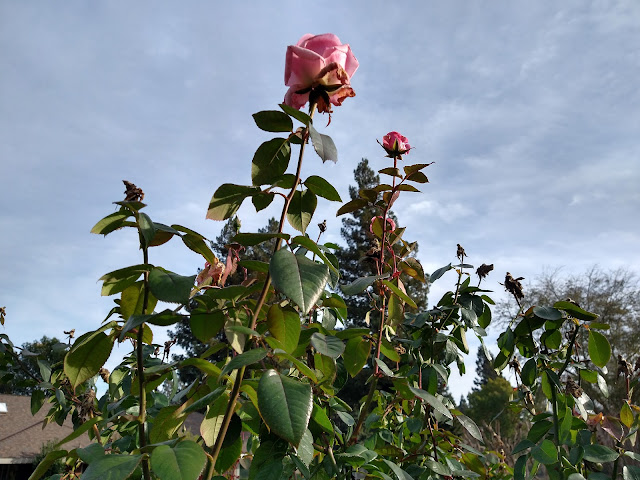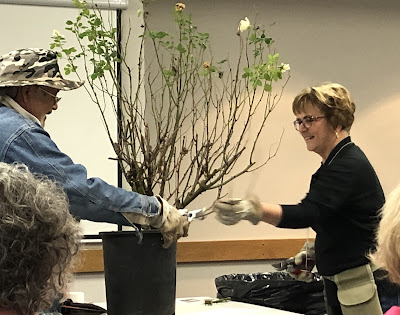
Master rosarian shares simple rose pruning tips

|
| This Pink Promise rose needs pruning -- it's 10 feet tall and still blooming in January. (Photo: Debbie Arrington) |
Why prune? Why now?
Those are prickly questions for anyone who grows roses.
January is rose pruning season in Sacramento. Why? It’s a time when roses usually are dormant, quietly sleeping through a cold winter. Any blooms have turned to orange hips. Foliage has dropped, revealing bare canes.
But not this year. A relatively warm winter and abundant rain prompted lush new growth on many large bushes. In my own garden, I have dozens of blooms on such hybrid teas as Pink Promise and First Prize.
Other bushes that lost their leaves are now showing signs of bud break, a swelling of nodes where new foliage emerges. Early bud break isn’t a problem – if the bush is already pruned. But if that bush is still a thatch of twisting canes, new growth just compounds problems.
Prune anyway, says master rosarian Charlotte Owendyk. If not now, later.
“What happens if you don’t prune? Life goes on; the roses will get bigger,” Owendyk said. “You can trim as needed during the growing season; just don’t do it in the heat of summer.”
Owendyk is one of the featured speakers at the Sierra Foothills Rose Society’s Winter Workshop. Set for 9 a.m. to 1 p.m. Jan. 15 at the Orangevale Grange Auditorium, the free in-person event covers a wide range of rose care topics from pest prevention to finding the right rose for the right place. The Grange is located at 5807 Walnut Ave., Orangevale; face masks are required.
Of course, pruning will be a big part of the discussion. Thursday, Owendyk offered a preview to the Sacramento Rose Society.
“Why prune? The plant needs it!” Owendyk said. “Pruning increases the plant’s vigor – you get more and bigger blooms. Pruning also helps achieve the desired shape and size for that bush. Prune for safety, too; you don’t want canes sticking out into walkways.”

|
|
Charlotte Owendyk holds a cane being pruned by Baldo Villegas
during their 2020 Winter Rose Care Workshop. (Photo:
Kathy Morrison)
|
“Generally, you don’t want to remove more than one third to one half of the bush’s height,” she explained. “But if a bush is already the right height or just small, it may only need a little touch up or trim.”
“When pruning, remember the three D’s: Dead, diseased, damaged. Take out any canes that fit in that category,” she added. “Just prune it; the plant will be happy.”
Pruning also allows time for re-evaluation and rejuvenation.
“Look at the structure,” Owendyk said. “Pruning is an opportunity to slowly, over a number of years, rejuvenate the plant. Remove old gray canes – one a year, not all at once – so new healthy canes can grow.”
When pruning, Owendyk always strives to open up the center of the plant, removing canes crossing in the middle. That allows for better air flow and cuts down on fungal disease. It also prompts more healthy new growth.
Strip off any leaves clinging to the remaining canes; it can contain fungal spores ready to infect new growth. Once done, clean up any debris.
“I always top-dress the soil, too,” Owendyk said. “It smothers any fungus on the ground.”
Comments
0 comments have been posted.Sacramento Digs Gardening to your inbox.
Sites We Like
Garden Checklist for week of April 21
This week there’s plenty to keep gardeners busy. With no rain in the immediate forecast, remember to irrigate any new transplants.
* Weed, weed, weed! Get them before they flower and go to seed.
* April is the last chance to plant citrus trees such as dwarf orange, lemon and kumquat. These trees also look good in landscaping and provide fresh fruit in winter.
* Smell orange blossoms? Feed citrus trees with a low dose of balanced fertilizer (such as 10-10-10) during bloom to help set fruit. Keep an eye out for ants.
* Apply slow-release fertilizer to the lawn.
* Thoroughly clean debris from the bottom of outdoor ponds or fountains.
* Spring brings a flush of rapid growth, and that means your garden is really hungry. Feed shrubs and trees with a slow-release fertilizer. Or mulch with a 1-inch layer of compost.
* Azaleas and camellias looking a little yellow? If leaves are turning yellow between the veins, give them a boost with chelated iron.
* Trim dead flowers but not leaves from spring-flowering bulbs such as daffodils and tulips. Those leaves gather energy to create next year's flowers. Also, give the bulbs a fertilizer boost after bloom.
* Pinch chrysanthemums back to 12 inches for fall flowers. Cut old stems to the ground.
* Mulch around plants to conserve moisture and control weeds.
* From seed, plant beans, beets, cantaloupes, carrots, corn, cucumbers, melons, radishes and squash.
* Plant onion sets.
* In the flower garden, plant seeds for asters, cosmos, celosia, marigolds, salvia, sunflowers and zinnias.
* Transplant petunias, zinnias, geraniums and other summer bloomers.
* Plant perennials and dahlia tubers for summer bloom.
* Mid to late April is about the last chance to plant summer bulbs, such as gladiolus and tuberous begonias.
* Transplant lettuce seedlings. Choose varieties that mature quickly such as loose leaf.